Quantification of the Outdoor Thermal Comfort within Different Oases Urban Fabrics
Abstract
:1. Introduction
- What are the various levels of outdoor thermal comfort in oases settlements in summer in the long-term?
- How severe is the impact of climate change on the outdoor thermal comfort during summer?
- How can the urban fabric design be adapted to mitigate high heat stress levels in Tolga oases settlements?
2. Literature Review
3. Methodology
3.1. Review of Literature
3.2. Defining of the Selection Criteria
3.2.1. Case Study
3.2.2. Selection Criteria
- Old neighborhood (S1):
- 2.
- Individual Housing neighborhood (S2):
- 3.
- Multifamily Housing neighborhood (S3):
- Measurement of meteorological parameters in the selected sites.
- Creation of the sites numerical models using ENVI-met software (https://www.envi-met.com/ accessed on 24 April 2020) [46].
- Validation of the numerical models based on measured parameters through: (1) mean bias error (MBE) and (2) root-mean-square error (RMSE) [47].
- Simulation of the main microclimatic parameters for quantifying the outdoor thermal comfort through the PET index.
- Calculation of PET index using RayMan model based on the simulated data.
3.2.3. Measurement of Meteorological Parameters
- (a)
- Old neighborhood (S1): (1, 2, 3).
- (b)
- Individual Housing neighborhood (S2): (4, 5, 6).
- (c)
- Multifamily Housing neighborhood (S3): (7, 8, 9).
3.2.4. Creation of the Three Models on ENVI-met 4.4.4
- (a)
- SPACES modeling on ENVI-met of all the selected sites:
- (b)
- Full forcing of the meteorological parameters measured:
- (c)
- Validation of ENVI-met, Measurement versus simulation:
3.2.5. Assessment of the Outdoor Thermal Comfort with PET Index
- (a)
- Simulation on ENVI-met of three models, using EPW data according to TMY2, TMY3 and TMYx files:
- (b)
- Output data simulation for 74 h: Ta. RH. Va. Tmrt:
- (c)
- Calculation of PET index using RayMan Pro:
4. Results
5. Discussion
5.1. Study Findings and Recommendations
5.2. Strength and Limitations
5.3. Implication on Practice and Research
6. Conclusions
Author Contributions
Funding
Institutional Review Board Statement
Informed Consent Statement
Data Availability Statement
Acknowledgments
Conflicts of Interest
Appendix A

References
- Battesti, V. Jardins au Désert: Évolution des Pratiques et Savoirs Oasiens: Jérid Tunisien; IRD Éditions: Marseille, France, 2005. [Google Scholar]
- Attia, S. Spatial and Behavioral Thermal Adaptation in Net Zero Energy Buildings: An Exploratory Investigation. Sustainability 2020, 12, 7961. [Google Scholar] [CrossRef]
- Coté, M. La Ville et le Désert: Le Bas-Sahara Algérien; Karthala Éditions: Paris, France, 2005. [Google Scholar]
- Ahriz, A.; Fezzai, S.; Mady, A.A.M. Predicting the limits of the oasis effect as a cooling phenomenon in hot deserts. Desert 2019, 24, 255–266. [Google Scholar]
- Matallah, M.E.; Alkama, D.; Ahriz, A.; Attia, S. Assessment of the Outdoor Thermal Comfort in Oases Settlements. Atmosphere 2020, 11, 185. [Google Scholar] [CrossRef] [Green Version]
- Potchter, O.; Ben-Shalom, H.I. Urban warming and global warming: Combined effect on thermal discomfort in the desert city of Beer Sheva, Israel. J. Arid. Environ. 2013, 98, 113–122. [Google Scholar] [CrossRef]
- Johansson, E. Influence of urban geometry on outdoor thermal comfort in a hot dry climate: A study in Fez, Morocco. Build. Environ. 2006, 41, 1326–1338. [Google Scholar] [CrossRef]
- Bourbia, F.; Awbi, H.B. Building cluster and shading in urban canyon for hot dry climate: Part 1: Air and surface temperature measurements. Renew. Energy 2004, 29, 249–262. [Google Scholar] [CrossRef]
- Bourbia, F.; Awbi, H.B. Building cluster and shading in urban canyon for hot dry climate: Part 2: Shading simulations. Renew. Energy 2004, 29, 291–301. [Google Scholar] [CrossRef]
- Jamei, E.; Rajagopalan, P.; Seyedmahmoudian, M.; Jamei, Y. Review on the impact of urban geometry and pedestrian level greening on outdoor thermal comfort. Renew. Sustain. Energy Rev. 2016, 54, 1002–1017. [Google Scholar] [CrossRef]
- Berardi, U.; Wang, Y. The Effect of a Denser City over the Urban Microclimate: The Case of Toronto. Sustainability 2016, 8, 822. [Google Scholar] [CrossRef]
- Tong, S.; Wong, N.H.; Tan, C.L.; Jusuf, S.K.; Ignatius, M.; Tan, E. Impact of urban morphology on microclimate and thermal comfort in northern China. Solar Energy 2017, 155, 212–223. [Google Scholar] [CrossRef]
- He, B.-J.; Ding, L.; Prasad, D. Relationships among local-scale urban morphology, urban ventilation, urban heat island and outdoor thermal comfort under sea breeze influence. Sustain. Cities Soc. 2020, 60, 102289. [Google Scholar] [CrossRef]
- Darbani, E.S.; Parapari, D.M.; Boland, J.; Sharifi, E. Impacts of urban form and urban heat island on the outdoor thermal comfort: A pilot study on Mashhad. Int. J. Biometeorol. 2021. [Google Scholar] [CrossRef]
- Mahmoud, A.H.A. Analysis of the microclimatic and human comfort conditions in an urban park in hot and arid regions. Build. Environ. 2011, 46, 2641–2656. [Google Scholar] [CrossRef]
- Venhari, A.A.; Tenpierik, M.; Taleghani, M. The role of sky view factor and urban street greenery in human thermal comfort and heat stress in a desert climate. J. Arid. Environ. 2019, 166, 68–76. [Google Scholar] [CrossRef]
- He, B.J.; Ding, L.; Prasad, D. Outdoor thermal environment of an open space under sea breeze: A mobile experience in a coastal city of Sydney, Australia. Urban Clim. 2020, 31, 100567. [Google Scholar] [CrossRef]
- Middel, A.; Selover, N.; Hagen, B.; Chhetri, N. Impact of shade on outdoor thermal comfort—A seasonal field study in Tempe, Arizona. Int. J. Biometeorol. 2016, 60, 1849–1861. [Google Scholar] [CrossRef] [Green Version]
- Balogun, I.A.; Daramola, M.T. The outdoor thermal comfort assessment of different urban configurations within Akure City, Nigeria. Urban Clim. 2019, 29, 100489. [Google Scholar] [CrossRef]
- Karakounos, I.; Dimoudi, A.; Zoras, S. The influence of bioclimatic urban redevelopment on outdoor thermal comfort. Energy Build. 2018, 158, 1266–1274. [Google Scholar] [CrossRef]
- Cohen, P.; Shashua-Bar, L.; Keller, R.; Gil-Ad, R.; Yaakov, Y.; Lukyanov, V.; Potchter, O. Urban outdoor thermal perception in hot arid Beer Sheva, Israel: Methodological and gender aspects. Build. Environ. 2019, 160, 106169. [Google Scholar] [CrossRef]
- Elnabawi, M.H.; Hamza, N.; Dudek, S. Thermal perception of outdoor urban spaces in the hot arid region of Cairo, Egypt. Sustain. Cities Soc. 2016, 22, 136–145. [Google Scholar] [CrossRef]
- Moufida, B.; Djamel, A.; Noureddine, M.; Soumia, B. The energy balance behavior in Open Street. Case study city of Biskra, Algeria. Energy Procedia 2014, 50, 3–9. [Google Scholar] [CrossRef] [Green Version]
- Masmoudi, S.; Mazouz, S. Relation of geometry, vegetation and thermal comfort around buildings in urban settings, the case of hot arid regions. Energy Build. 2004, 36, 710–719. [Google Scholar] [CrossRef]
- Teller, J.; Azar, S. Townscope II—A computer system to support solar access decision-making. Sol. Energy 2001, 70, 187–200. [Google Scholar] [CrossRef] [Green Version]
- Bruse, M.; Fleer, H. Simulating surface–plant–air interactions inside urban environments with a three dimensional numerical model. Environ. Model. Softw. 1998, 13, 373–384. [Google Scholar] [CrossRef]
- Bruse, M. ENVI-Met 3.0: Updated Model Overview. University of Bochum. 2004. Available online: www.envi-met.com (accessed on 24 April 2020).
- Matzarakis, A.; Rutz, F.; Mayer, H. Modelling radiation fluxes in simple and complex environments—Application of the RayMan model. Int. J. Biometeorol. 2007, 51, 323–334. [Google Scholar] [CrossRef]
- Matzarakis, A.; Rutz, F.; Mayer, H. Modelling radiation fluxes in simple and complex environments: Basics of the RayMan model. Int. J. Biometeorol. 2010, 54, 131–139. [Google Scholar] [CrossRef] [PubMed] [Green Version]
- Tsoka, S.; Tsikaloudaki, A.; Theodosiou, T. Analyzing the ENVI-met microclimate model’s performance and assessing cool materials and urban vegetation applications–A review. Sustain. Cities Soc. 2018, 43, 55–76. [Google Scholar] [CrossRef]
- Sharmin, T.; Steemers, K.; Matzarakis, A. Microclimatic modelling in assessing the impact of urban geometry on urban thermal environment. Sustain. Cities Soc. 2017, 34, 293–308. [Google Scholar] [CrossRef]
- Ali-Toudert, F.; Mayer, H. Numerical study on the effects of aspect ratio and orientation of an urban street canyon on outdoor thermal comfort in hot and dry climate. Build. Environ. 2006, 41, 94–108. [Google Scholar] [CrossRef]
- Sodoudi, S.; Zhang, H.; Chi, X.; Müller, F.; Li, H. The influence of spatial configuration of green areas on microclimate and thermal comfort. Urban For. Urban Green. 2018, 34, 85–96. [Google Scholar] [CrossRef]
- Zhao, Q.; Sailor, D.J.; Wentz, E.A. Impact of tree locations and arrangements on outdoor microclimates and human thermal comfort in an urban residential environment. Urban For. Urban Green. 2018, 32, 81–91. [Google Scholar] [CrossRef] [Green Version]
- Deng, J.Y.; Wong, N.H. Impact of urban canyon geometries on outdoor thermal comfort in central business districts. Sustain. Cities Soc. 2020, 53, 101966. [Google Scholar] [CrossRef]
- Berkovic, S.; Yezioro, A.; Bitan, A. Study of thermal comfort in courtyards in a hot arid climate. Sol. Energy 2012, 86, 1173–1186. [Google Scholar] [CrossRef]
- Ambrosini, D.; Galli, G.; Mancini, B.; Nardi, I.; Sfarra, S. Evaluating mitigation effects of urban heat islands in a historical small center with the ENVI-Met® climate model. Sustainability 2014, 6, 7013–7029. [Google Scholar] [CrossRef] [Green Version]
- Acero, J.A.; Arrizabalaga, J. Evaluating the performance of ENVI-met model in diurnal cycles for different meteorological conditions. Theor. Appl. Clim. 2018, 131, 455–469. [Google Scholar] [CrossRef]
- Boukhabl, M.; Alkam, D. Impact of Vegetation on Thermal Conditions Outside, Thermal Modeling of Urban Microclimate, Case Study: The Street of the Republic, Biskra. Energy Procedia 2012, 18, 73–84. [Google Scholar] [CrossRef] [Green Version]
- Boukhelkhal, I.; Bourbia, P.F. Thermal comfort conditions in outdoor urban spaces: Hot dry climate-Ghardaia-Algeria. Procedia Eng. 2016, 169, 207–215. [Google Scholar] [CrossRef]
- Kedissa, C.; Outtas, S.; Belarbi, R. The impact of height/width ratio on the microclimate and thermal comfort levels of urban courtyards. Int. J. Sustain. Build. Technol. Urban Dev. 2016, 7, 174–183. [Google Scholar] [CrossRef]
- Berkouk, D.; Bouzir, T.A.K.; Maffei, L.; Masullo, M. Examining the Associations between Oases Soundscape Components and Walking Speed: Correlation or Causation? Sustainability 2020, 12, 4619. [Google Scholar] [CrossRef]
- Côte, M. Signatures Sahariennes: Terroirs & Territoires Vus du Ciel; Presses Universitaires de Provence (PUP): Aix-en-Provence, France, 2012. [Google Scholar]
- Alkama, D.; Tacherift, A. Essai d’analyse typo-morphologique des noyaux urbains traditionnels dans la région des Ziban. Courrier du Savoir 2001, 1, 81–88. [Google Scholar]
- Semahi, S.; Benbouras, M.A.; Mahar, W.A.; Zemmouri, N.; Attia, S. Development of Spatial Distribution Maps for Energy Demand and Thermal Comfort Estimation in Algeria. Sustainability 2020, 12, 6066. [Google Scholar] [CrossRef]
- ENVI-Met Software. 2019. Available online: https://www.envi-met.com/ (accessed on 24 April 2020).
- ASHRAE. ASHRAE Guideline 14-2002. Measurement of Energy and Demand Savings, 8400; ASHRAE: Atlanta, GA, USA, 2002. [Google Scholar]
- Matallah, M.E.; Ahriz, A.; Attia, S. Quantification of the Outdoor Thermal Comfort Process: Simulation & Calculation Data; Sustainable Building Design Lab., Ed.; University of Liège: Liège, Belgium, 2020. [Google Scholar]
- TESTO. TESTO 480 Climate Measuring Instrument; TESTO Instruments: 2020. Available online: https://static-int.testo.com/media/cf/01/1ff8d8380280/testo-480-Instruction-manual.pdf (accessed on 18 December 2020).
- Taleghani, M.; Kleerekoper, L.; Tenpierik, M.; Dobbelsteen, A.V.D. Outdoor thermal comfort within five different urban forms in the Netherlands. Build. Environ. 2015, 83, 65–78. [Google Scholar] [CrossRef]
- Ratti, C.; Baker, N.; Steemers, K. Energy consumption and urban texture. Energy Build. 2005, 37, 762–776. [Google Scholar] [CrossRef]
- Ali-Toudert, F.; Mayer, H. Effects of asymmetry, galleries, overhanging façades and vegetation on thermal comfort in urban street canyons. Sol. Energy 2007, 81, 742–754. [Google Scholar] [CrossRef]
- Semahi, S.; Zemmouri, N.; Singh, M.K.; Attia, S. Comparative bioclimatic approach for comfort and passive heating and cooling strategies in Algeria. Build. Environ. 2019, 161, 106271. [Google Scholar] [CrossRef] [Green Version]
- Hien, W.N.; Ignatius, M.; Eliza, A.; Jusuf, S.K.; Samsudin, R. Comparison of STEVE and ENVI-met as temperature prediction models for Singapore context. Int. J. Sustain. Build. Technol. Urban Dev. 2012, 3, 197–209. [Google Scholar] [CrossRef]
- Meteonorm Software. Available online: https://meteonorm.com/en/ (accessed on 20 August 2020).
- Climate.OneBuilding. Repository of Free Climate Data for Building Performance Simulation. 2020. Available online: http://climate.onebuilding.org/ (accessed on 20 March 2020).
- Potchter, O.; Cohen, P.; Lin, T.P.; Matzarakis, A. Outdoor human thermal perception in various climates: A comprehensive review of approaches, methods and quantification. Sci. Total Environ. 2018, 631, 390–406. [Google Scholar] [CrossRef]
- Oke, T.R. Boundary Layer Climates; Routledge: London, UK, 2002. [Google Scholar]
- Boudjellal, L.; Bourbia, F. An evaluation of the cooling effect efficiency of the oasis structure in a Saharan town through remotely sensed data. Int. J. Environ. Stud. 2018, 75, 309–320. [Google Scholar] [CrossRef]
- Taleghani, M. Outdoor thermal comfort by different heat mitigation strategies—A review. Renew. Sustain. Energy Rev. 2018, 81, 2011–2018. [Google Scholar] [CrossRef]
- Potchter, O.; Goldman, D.; Kadish, D.; Iluz, D. The oasis effect in an extremely hot and arid climate: The case of southern Israel. J. Arid. Environ. 2008, 72, 1721–1733. [Google Scholar] [CrossRef]
- Rogelj, J.; Meinshausen, M.; Knutti, R. Global warming under old and new scenarios using IPCC climate sensitivity range estimates. Nat. Clim. Change 2012, 2, 248–253. [Google Scholar] [CrossRef]

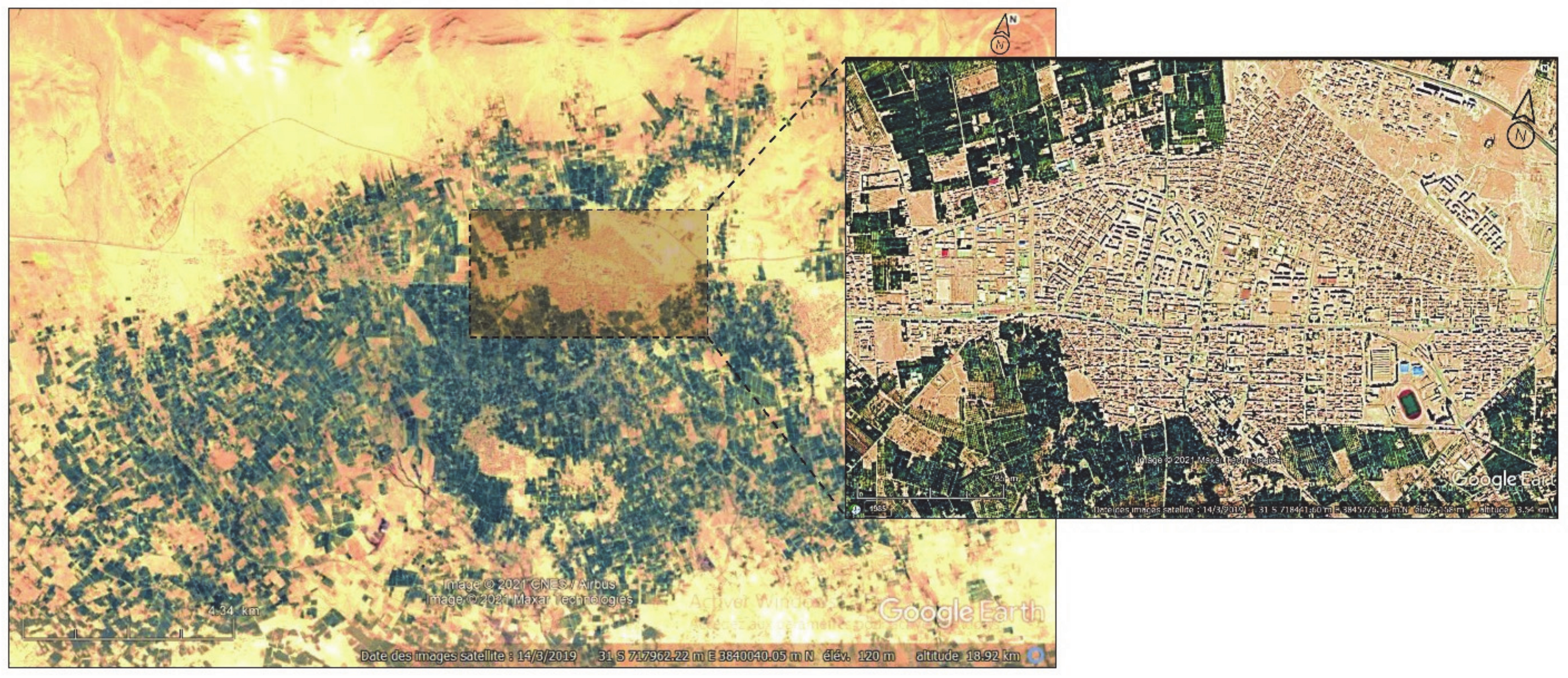
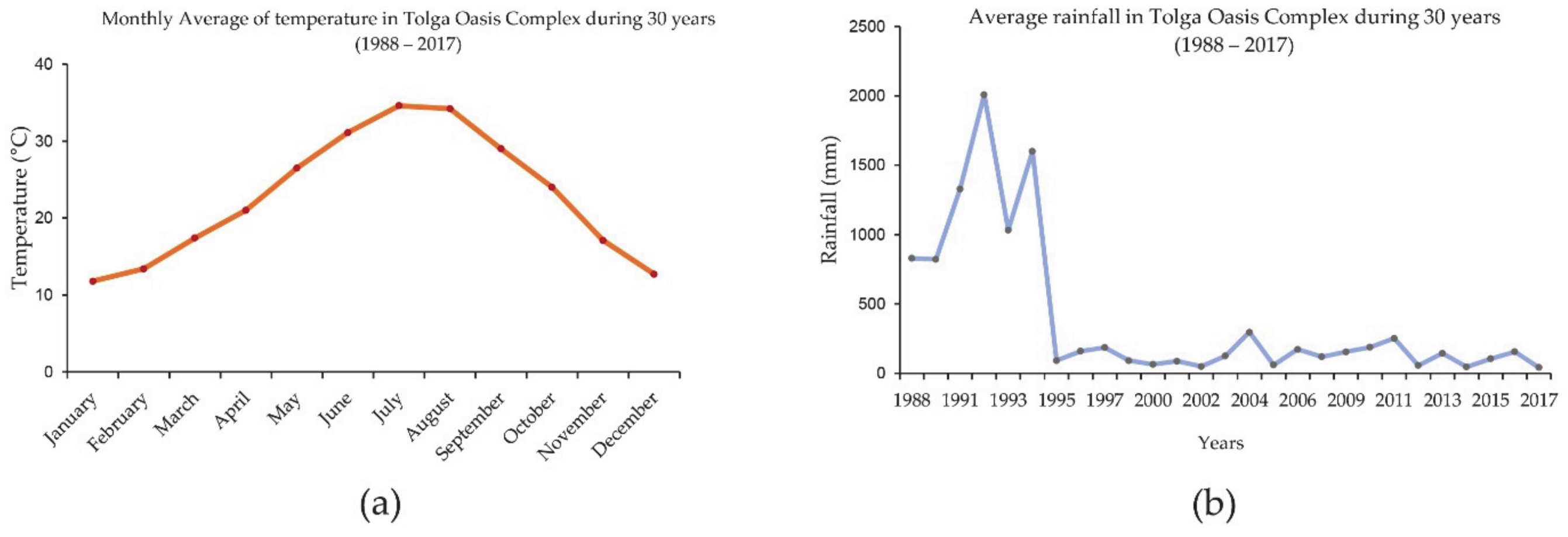


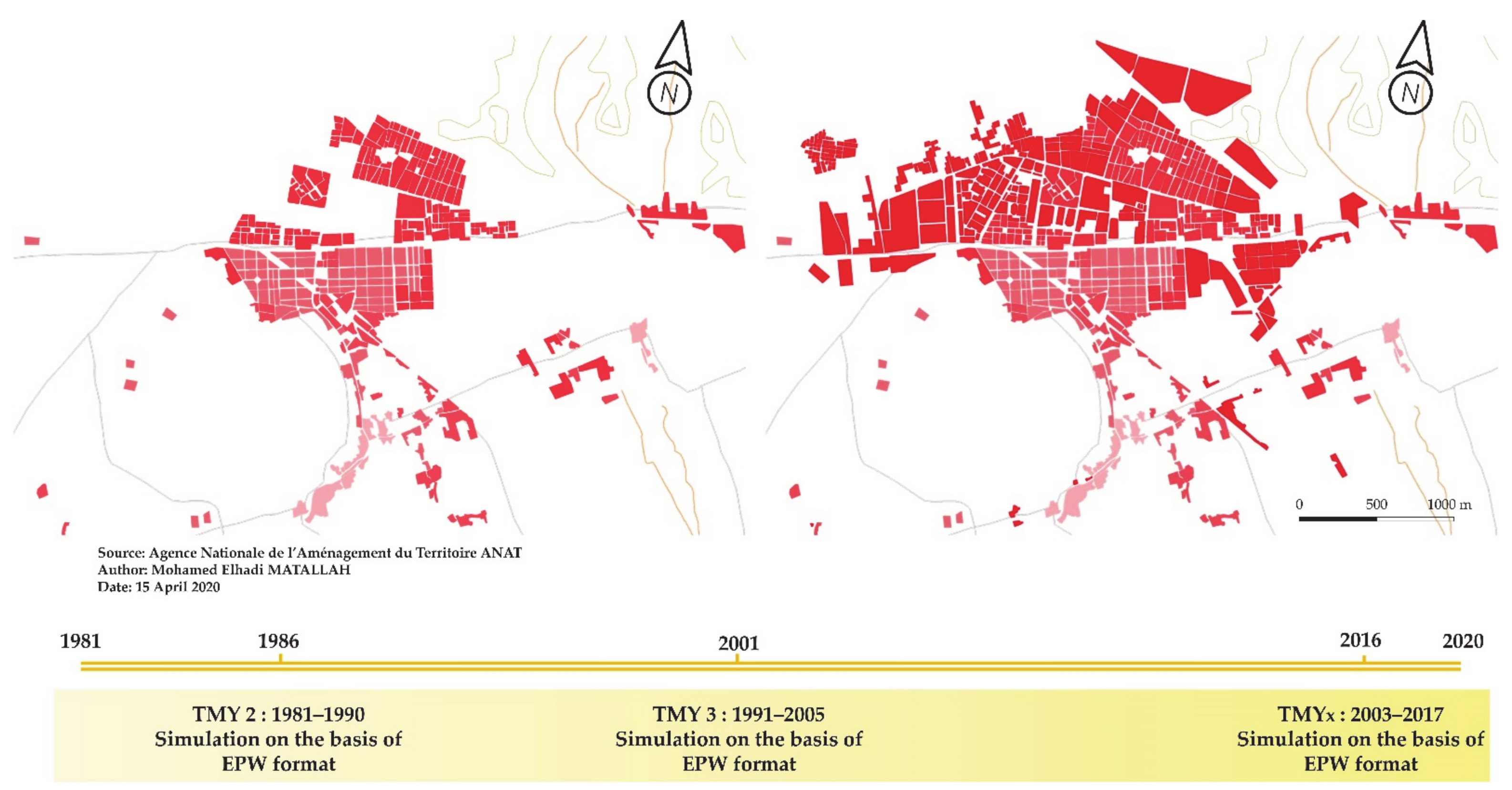
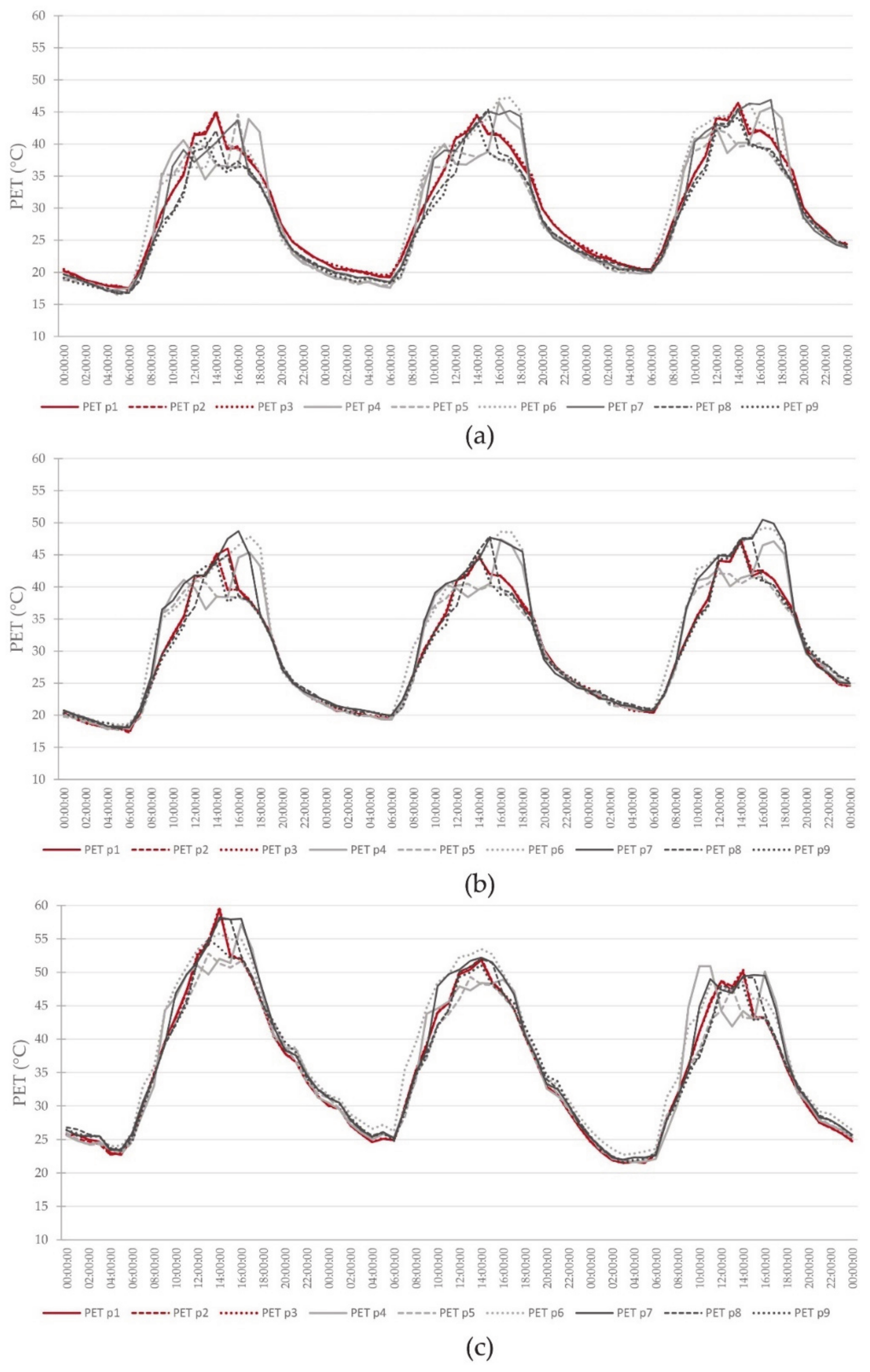
| Morphological Parameters | Old Neighborhood (S1) | Individual Housing Neighborhood (S2) | Multifamily Housing Neighborhood (S3) | ||||||
|---|---|---|---|---|---|---|---|---|---|
| Urban grids | 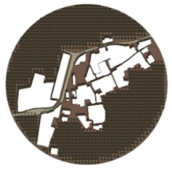 |  | 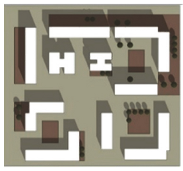 | ||||||
| Built-up area (m2) | 14,000 | 22,000 | 28,000 | ||||||
| Measurement points | 1 | 2 | 3 | 4 | 5 | 6 | 7 | 8 | 9 |
| Length (m) | 50.35 | 150.00 | 58.70 | 72.20 | 40.00 | 56.10 | 45.70 | 56.00 | 75.00 |
| Height (m) | 3.70 | 7.10 | 3.00 | 6.40 | 6.40 | - | 12.50 | 12.50 | 12.50 |
| Width (m) | 3.40 | 3.15 | 4.00 | 3.20 | 3.90 | - | - | 12.50 | 14.00 |
| H/W | 1.09 | 2.25 | 0.75 | 2.00 | 1.64 | - | - | 1 | 0.89 |
| Street orientation | N-S | E-W | N-S | E-W | N-S | - | - | N-S | E-W |
| Sky View Factor (SVF) | 0.32 | 0.18 | 0.56 | 0.39 | 0.42 | 0.67 | 0.87 | 0.78 | 0.64 |
| Fish-eye |  |  |  |  |  |  |  |  |  |
| Tree specie | Phoenix dactylifera—Grass | Ficus rubiginosa—Grass | Ficus rubiginosa—Grass | ||||||
| Meteorological Data Parameters | |||||
|---|---|---|---|---|---|
| Variable | Device | Probe Reference | Unit | Accuracy | Range |
| Air temperature (Ta) | Testo 480 0563 4800 | 12 Φ 0636 9743 | °C | ±0.5 °C | −20 to +70 °C |
| Kimo HD 100 | 13 Φ lg. 110 mm | °C | ±0.3 °C | −20 to +80 °C | |
| Relative humidity (RH.) | Testo 480 0563 4800 | 12 Φ 0636 9743 | % | ±1.0% | 0% to 100% |
| Kimo HD 100 | 13 Φ lg. 110 mm | % | ±1.8% | 5% to 95% | |
| Wind velocity (Va) | Testo 480 0563 4800 | Helix 100 Φ mm 0635 9343 | m/s | ±0.1 m/s | 0.1 to 15 m/s |
| Kimo LV 100 | Helix 100 Φ mm lg. 310 mm | m/s | ±0.1 m/s ±0.2 m/s | 0.2 to 3 m/s 3.1 to 35 m/s | |
| Fish-Eye Images Parameters | |||||
| Camera | Focal length | Resolution | Dimensions | Colors representation | |
| Canon EOS 6D | 8 mm | 72 ppp | 5472 × 3648 | sRGB | |
| Old Neighborhood (S1) | Individual Housing Neighborhood (S2) | Multifamily Housing Neighborhood (S3) | |||||||
|---|---|---|---|---|---|---|---|---|---|
| Street orientation | 1 | 2 | 3 | 4 | 5 | 6 | 7 | 8 | 9 |
| N-S | E-W | N-S | E-W | N-S | - | - | N-S | E-W | |
| Model area | |||||||||
| Main Model Area | 240 m × 240 m | 120 m × 120 m | 120 m × 120 m | ||||||
| Grid size in meter | |||||||||
| dx = size of X grid | dx = 2 | dx = 2 | dx = 2 | ||||||
| dy = size of Y grid | dy = 2 | dy = 2 | dy = 2 | ||||||
| dz = size of Z grid | dz = 2 | dz = 1 | dz = 1 | ||||||
| Construction material | |||||||||
| Building material | Wall: brick wall (burned). Roof: lightweight concrete | Wall: cast dense concrete. Roof: lightweight concrete | Wall: brick wall (aerated). Roof: lightweight concrete | ||||||
| Soil | Road: asphalt. Natural surfaces: loamy soil | Road: asphalt. Pavement: concrete pavement grey. Pavement concrete used/dirty. Natural surfaces: loamy soil | Road: asphalt. Pavement: concrete pavement grey. Natural surfaces: loamy soil | ||||||
| Vegetation | Palm Trees: Palm, large trunk, dense, medium (15 m); Grass: 50 cm aver. dense | New deciduous Trees: spherical (small trunk. sparse. small (5 m)); Grass: 50 cm aver. dense | New deciduous Trees: spherical (small trunk. sparse. small (5 m)); Grass: 50 cm aver. dense | ||||||
| 3D model | 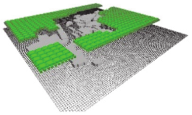 | 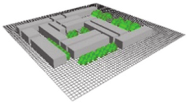 | 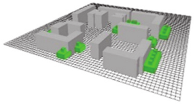 | ||||||
| Position | |||||||||
| Longitude (°) | 34.93 | same | same | ||||||
| Latitude (°) | 5.13 | same | same | ||||||
| Start and duration of the model | |||||||||
| Date of Simulation | 28–29/07/2018 | 25–26/07/2018 | 15–16/07/2014 | ||||||
| Start time | 00:00 | same | same | ||||||
| Total simulation time (h) | 48 | 48 | 48 | ||||||
| Initial meteorological conditions | |||||||||
| Full forcing | CSV data | same | same | ||||||
| Sample | Indices | Point 1 | Point 2 | Point 3 | |||
|---|---|---|---|---|---|---|---|
| S1 | RMSE | 0.69 | 1.93% | 0.76 | 2.12% | 0.60 | 1.67% |
| MBE | −0.62 | 1.74% | −0.69 | 1.93% | −0.53 | 1.48% | |
| S2 | RMSE | 2.22 | 6.44% | 2.77 | 7.88% | 2.46 | 6.99% |
| MBE | −1.01 | 2.94% | −1.89 | 5.37% | −1.50 | 4.26% | |
| S3 | RMSE | 2.92 | 8.75% | 2.98 | 8.96% | 3.75 | 10.70% |
| MBE | −0.36 | 1.08% | −0.44 | 1.31% | −1.99 | 5.67% | |
| Date | Time | PET.—S1 | PET.—S2 | PET.—S3 | ||||||
|---|---|---|---|---|---|---|---|---|---|---|
| 1 | 2 | 3 | 4 | 5 | 6 | 7 | 8 | 9 | ||
| 0.32 | 0.18 | 0.56 | 0.39 | 0.42 | 0.67 | 0.87 | 0.78 | 0.64 | ||
| 15.07.1986 | 00:00 | 20.2 | 20.2 | 20.5 | 19.2 | 18.8 | 19.7 | 19.7 | 19.7 | 19.1 |
| 01:00 | 19.7 | 19.4 | 19.5 | 19 | 18.6 | 19.1 | 19.2 | 19.1 | 18.4 | |
| 02:00 | 18.8 | 18.8 | 18.8 | 18.4 | 18.6 | 18.5 | 18.5 | 18.5 | 18.1 | |
| 03:00 | 18.4 | 18.3 | 18.3 | 17.8 | 18.1 | 18 | 17.9 | 17.8 | 17.6 | |
| 04:00 | 17.9 | 17.9 | 18 | 17.1 | 17.6 | 17.3 | 17.1 | 17.1 | 17.5 | |
| 05:00 | 17.7 | 17.9 | 17.9 | 17.4 | 17.4 | 17.9 | 17.1 | 17.1 | 17.3 | |
| 06:00 | 17.6 | 17.2 | 17.4 | 17.5 | 17.2 | 17.9 | 17 | 17.2 | 17.1 | |
| 07:00 | 20.3 | 20.7 | 20.3 | 19.8 | 18.8 | 22 | 20 | 18.7 | 18.9 | |
| 08:00 | 25 | 25 | 24.9 | 23.2 | 23.6 | 29.9 | 23.9 | 23.8 | 23.3 | |
| 09:00 | 29.5 | 29.4 | 29.3 | 34.9 | 35.4 | 33.8 | 27.8 | 27.8 | 26.9 | |
| 10:00 | 32.6 | 32.5 | 32.6 | 38.7 | 35.1 | 34.9 | 36.5 | 29.4 | 29.2 | |
| 11:00 | 35.1 | 35.3 | 35.4 | 40.6 | 37.7 | 36.5 | 39.1 | 32.6 | 31.9 | |
| 12:00 | 41.4 | 41.5 | 41.6 | 38.1 | 40.1 | 36.4 | 37.2 | 38.9 | 39.8 | |
| 13:00 | 41.5 | 41.8 | 41.9 | 34.5 | 39.5 | 36.2 | 38.7 | 39.4 | 40.9 | |
| 14:00 | 44.8 | 45.1 | 45.1 | 36.7 | 36.7 | 40.4 | 40.2 | 42.1 | 37.1 | |
| 15:00 | 39.2 | 39.3 | 39.6 | 36.5 | 36.4 | 40 | 42.1 | 36.2 | 35.6 | |
| 16:00 | 39.4 | 39.6 | 39.6 | 36.4 | 44.6 | 39.1 | 43.7 | 37.3 | 36.5 | |
| 17:00 | 37.5 | 37.8 | 38 | 43.9 | 35.9 | 38.9 | 35.3 | 35.9 | 36.2 | |
| 18:00 | 35.5 | 35.5 | 35.5 | 41.9 | 33.8 | 35.6 | 33.7 | 33.9 | 33.5 | |
| 19:00 | 32.3 | 32.5 | 32.3 | 30.8 | 30.2 | 30.4 | 30.5 | 30.3 | 30.5 | |
| 20:00 | 27.5 | 27.4 | 27.4 | 27.1 | 25.7 | 25.1 | 26 | 26 | 26 | |
| 21:00 | 24.8 | 24.8 | 24.9 | 22.9 | 23.3 | 23 | 23.5 | 23.6 | 23.6 | |
| 22:00 | 23.6 | 23.4 | 23.5 | 21.4 | 21.8 | 22.1 | 22.1 | 22.4 | 22.3 | |
| 23:00 | 22.4 | 22.3 | 22.3 | 20.8 | 20.5 | 21 | 21.2 | 21.5 | 21.2 | |
| Thermal comfort stress level | 17–26 | 26–28 | 28–37 | 37–42 | >42 | |||||
| Neutral | Slightly warm | Warm | Hot | Very hot | ||||||
| No thermal stress | Slight heat stress | Moderate heat stress | Strong heat stress | Extreme heat stress | ||||||
| Date | Time | PET.—S1 | PET.—S2 | PET.—S3 | ||||||
|---|---|---|---|---|---|---|---|---|---|---|
| 1 | 2 | 3 | 4 | 5 | 6 | 7 | 8 | 9 | ||
| 0.32 | 0.18 | 0.56 | 0.39 | 0.42 | 0.67 | 0.87 | 0.78 | 0.64 | ||
| 15.07.2001 | 00:00 | 20.3 | 20.4 | 20.3 | 20.1 | 19.8 | 20.6 | 20.8 | 20.7 | 20.3 |
| 01:00 | 19.7 | 19.5 | 19.5 | 19.8 | 19.5 | 20.3 | 20.1 | 20 | 19.7 | |
| 02:00 | 18.9 | 18.8 | 18.8 | 19.2 | 18.9 | 19.6 | 19.6 | 19.5 | 19.4 | |
| 03:00 | 18.4 | 18.4 | 18.4 | 18.6 | 18.6 | 19.1 | 19 | 18.8 | 18.9 | |
| 04:00 | 18 | 17.9 | 18 | 17.8 | 18 | 18.8 | 18.3 | 18.3 | 18.8 | |
| 05:00 | 18 | 18 | 18 | 18.4 | 17.7 | 18.5 | 18.2 | 17.9 | 18 | |
| 06:00 | 17.6 | 17.3 | 17.3 | 17.8 | 18.2 | 18.7 | 18.1 | 18.2 | 18.5 | |
| 07:00 | 20.3 | 20.9 | 20.9 | 20.8 | 19.6 | 20.9 | 21.1 | 20.3 | 20.3 | |
| 08:00 | 25 | 25.1 | 24.9 | 24.6 | 24.5 | 30.8 | 26 | 25.1 | 24.7 | |
| 09:00 | 29.5 | 29.5 | 29.4 | 35.8 | 35.8 | 35.1 | 36.5 | 29.5 | 28.8 | |
| 10:00 | 32.6 | 32.4 | 32.6 | 39.2 | 37 | 36.4 | 37.9 | 31.9 | 31.2 | |
| 11:00 | 35.5 | 35.3 | 35.4 | 41.1 | 39.3 | 38 | 40.5 | 34.6 | 33.9 | |
| 12:00 | 41.6 | 41.5 | 41.6 | 39.8 | 41 | 41.4 | 41.8 | 36.9 | 42 | |
| 13:00 | 41.7 | 41.9 | 41.9 | 36.5 | 40.6 | 41.6 | 41.8 | 42.4 | 43.2 | |
| 14:00 | 45 | 45.2 | 45.2 | 38.5 | 38.5 | 43.7 | 44.3 | 43.8 | 43.8 | |
| 15:00 | 46 | 39.5 | 39.6 | 38.4 | 38.4 | 44.9 | 47.5 | 45 | 37.7 | |
| 16:00 | 39.6 | 39.6 | 39.6 | 44.6 | 38.4 | 46.5 | 48.7 | 38.6 | 38.6 | |
| 17:00 | 37.6 | 38 | 38 | 45.4 | 37.6 | 47.9 | 45 | 37.8 | 37.8 | |
| 18:00 | 35.6 | 35.6 | 35.6 | 43.2 | 35.5 | 46.2 | 35.5 | 35.7 | 35.4 | |
| 19:00 | 32.4 | 32.6 | 32.3 | 32.3 | 32 | 32.4 | 32.1 | 32.2 | 32.1 | |
| 20:00 | 27.3 | 27.7 | 27.4 | 27.6 | 27.4 | 26.8 | 27.1 | 27.7 | 27.7 | |
| 21:00 | 24.9 | 25.1 | 24.9 | 25.1 | 24.9 | 24.8 | 25 | 25.2 | 25.3 | |
| 22:00 | 23.6 | 23.5 | 23.5 | 23.4 | 23.5 | 23.8 | 23.7 | 24.2 | 24 | |
| 23:00 | 22.4 | 22.4 | 22.3 | 22.4 | 22.5 | 22.7 | 22.9 | 23.2 | 23.1 | |
| Thermal comfort stress level | 17–26 | 26–28 | 28–37 | 37–42 | >42 | |||||
| Neutral | Slightly warm | Warm | Hot | Very hot | ||||||
| No thermal stress | Slight heat stress | Moderate heat stress | Strong heat stress | Extreme heat stress | ||||||
| Date | Time | PET.—S1 | PET.—S2 | PET.—S3 | ||||||
|---|---|---|---|---|---|---|---|---|---|---|
| 1 | 2 | 3 | 4 | 5 | 6 | 7 | 8 | 9 | ||
| 0.32 | 0.18 | 0.56 | 0.39 | 0.42 | 0.67 | 0.87 | 0.78 | 0.64 | ||
| 15.07.2016 | 00:00 | 25.7 | 25.6 | 25.7 | 25.6 | 26 | 26.5 | 26.4 | 26.8 | 26.4 |
| 01:00 | 25.7 | 25.1 | 25.6 | 24.8 | 25 | 25.9 | 25.6 | 26.5 | 25.8 | |
| 02:00 | 25 | 24.7 | 24.9 | 24.3 | 24.2 | 25.6 | 25.5 | 25.8 | 25.4 | |
| 03:00 | 24.7 | 24.3 | 24.7 | 24.6 | 24.3 | 25.4 | 25.5 | 25.4 | 25.5 | |
| 04:00 | 23 | 22.7 | 22.8 | 23.6 | 23.5 | 24 | 23.4 | 23.7 | 23.7 | |
| 05:00 | 22.7 | 23 | 23.2 | 23.2 | 22.9 | 24.1 | 23.5 | 23.3 | 23.6 | |
| 06:00 | 25.1 | 25.3 | 25.5 | 25.1 | 24.6 | 26 | 25.9 | 25.4 | 24.7 | |
| 07:00 | 30.3 | 30.3 | 30.3 | 29 | 29.5 | 33 | 30.7 | 30.3 | 29.6 | |
| 08:00 | 34.5 | 34.8 | 34.8 | 33 | 34.5 | 35.8 | 34.4 | 34.4 | 34.4 | |
| 09:00 | 39.6 | 39.7 | 39.6 | 44.3 | 39.4 | 44.2 | 39.2 | 39.2 | 39.3 | |
| 10:00 | 43.4 | 43.2 | 43 | 46.3 | 42.6 | 48 | 46.9 | 42.2 | 42.2 | |
| 11:00 | 47.4 | 47.2 | 47 | 49.7 | 45.5 | 50.8 | 49.7 | 45.9 | 45.2 | |
| 12:00 | 52.6 | 52.3 | 52.9 | 51 | 49 | 53.4 | 51.6 | 51.6 | 51.9 | |
| 13:00 | 54.1 | 54.9 | 54.5 | 49.7 | 52.8 | 54.9 | 54.3 | 54.6 | 55 | |
| 14:00 | 59.5 | 59.2 | 59.7 | 52 | 51.3 | 55.8 | 58.2 | 57.9 | 53.7 | |
| 15:00 | 52.3 | 52.6 | 52.5 | 51.4 | 50.7 | 54.9 | 57.9 | 58 | 52.1 | |
| 16:00 | 52 | 52 | 51.9 | 57.2 | 51.7 | 55 | 58 | 52.4 | 52.1 | |
| 17:00 | 49 | 49 | 49 | 53.5 | 49.5 | 51.6 | 52.5 | 49.3 | 49.2 | |
| 18:00 | 44.8 | 44.8 | 44.7 | 46.4 | 44.5 | 45.1 | 47.1 | 45.1 | 45.1 | |
| 19:00 | 40.4 | 40.6 | 40.4 | 40.6 | 42.5 | 40 | 41.8 | 41.7 | 42.5 | |
| 20:00 | 37.9 | 37.8 | 37.9 | 38.7 | 39 | 39.1 | 38.3 | 38.5 | 39.6 | |
| 21:00 | 36.6 | 36.6 | 36.7 | 38.5 | 36.6 | 38.7 | 37.6 | 37.6 | 38 | |
| 22:00 | 33.6 | 33.7 | 33.7 | 35 | 33.7 | 35.1 | 34.7 | 34.3 | 34.2 | |
| 23:00 | 31.5 | 31.5 | 31.5 | 31.3 | 31.9 | 33.2 | 32.5 | 32.6 | 32.4 | |
| Thermal comfort stress level | 17–26 | 26–28 | 28–37 | 37–42 | >42 | |||||
| Neutral | Slightly warm | Warm | Hot | Very hot | ||||||
| No thermal stress | Slight heat stress | Moderate heat stress | Strong heat stress | Extreme heat stress | ||||||
| Sites | TMY2 | TMY3 | TMYx | ||||
|---|---|---|---|---|---|---|---|
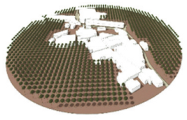 | 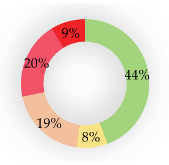 | 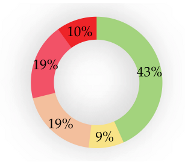 |  | ||||
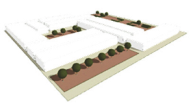 | 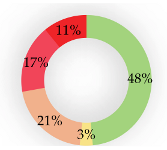 | 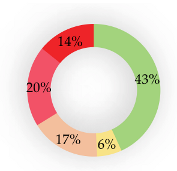 | 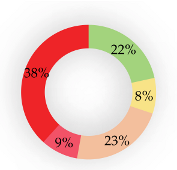 | ||||
 | 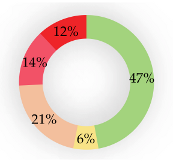 | 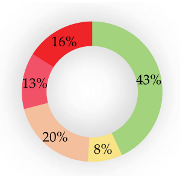 | 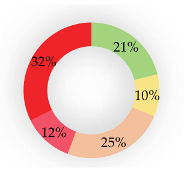 | ||||
| Thermal comfort stress level | 17–26 | 26–28 | 28–37 | 37–42 | >42 | ||
| Neutral | Slightly warm | Warm | Hot | Very hot | |||
| No thermal stress | Slight heat stress | Moderate heat stress | Strong heat stress | Extreme heat stress | |||
Publisher’s Note: MDPI stays neutral with regard to jurisdictional claims in published maps and institutional affiliations. |
© 2021 by the authors. Licensee MDPI, Basel, Switzerland. This article is an open access article distributed under the terms and conditions of the Creative Commons Attribution (CC BY) license (http://creativecommons.org/licenses/by/4.0/).
Share and Cite
Matallah, M.E.; Alkama, D.; Teller, J.; Ahriz, A.; Attia, S. Quantification of the Outdoor Thermal Comfort within Different Oases Urban Fabrics. Sustainability 2021, 13, 3051. https://doi.org/10.3390/su13063051
Matallah ME, Alkama D, Teller J, Ahriz A, Attia S. Quantification of the Outdoor Thermal Comfort within Different Oases Urban Fabrics. Sustainability. 2021; 13(6):3051. https://doi.org/10.3390/su13063051
Chicago/Turabian StyleMatallah, Mohamed Elhadi, Djamel Alkama, Jacques Teller, Atef Ahriz, and Shady Attia. 2021. "Quantification of the Outdoor Thermal Comfort within Different Oases Urban Fabrics" Sustainability 13, no. 6: 3051. https://doi.org/10.3390/su13063051







